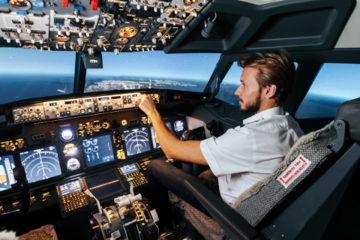Draper Scholar Leads Study that Could Detect Spatial Disorientation in Flight
CAMBRIDGE, MA—The number of airplane accidents involving spatial disorientation (SD) has remained constant in recent years even as the total number of accidents and incidents has declined. The inability to tell up from down or identify a visual reference point is a leading cause of Class A mishaps and fatalities across the world and the leader in many branches of the U.S. military.
Pilots, despite having several attitude instruments in the cockpit to help them steady their aircraft, can be unaware they have lost an accurate sense of orientation. That fact raises concerns among aviation safety experts. Reports show that when spatial disorientation is a contributing factor to an accident, fatalities are three times more likely to happen in comparison to all other aviation accidents.
Jordan Dixon, an aerospace engineer, has made a study of spatial disorientation and found that current countermeasures, like alarms and lights, are inadequate alone for keeping pilots safe. Pilots can experience sensory overload when too many or the wrong countermeasures are activated, which can only make a bad situation worse. Dixon’s answer is a system that monitors individual pilots and triggers countermeasures only when a pilot is at risk of spatial disorientation.
“Spatial disorientation is a major cause of deadly aircraft mishaps, despite improvements in night vision, heads-up displays and cockpit automation,” said Dixon, a Ph.D. candidate at the University of Colorado Boulder. “What we need are better models to predict disorientation and a system that can be installed in an aircraft that alerts pilots to various spatial disorientation conditions.”
Dixon’s approach is to understand spatial disorientation from the pilot’s perspective. By modeling pilot behaviors such as perception of visual cues and eye-tracking for instrument scan updates, Dixon hopes to use human-centered solutions to tamp down instances of spatial disorientation.
To build his model, Dixon interviewed pilots who had experienced spatial disorientation in-flight. He also began collecting human-in-the-loop flight data using a ground-based motion simulator. The data sets will be used to identify optimal computational algorithms that capture a human’s orientation perception during SD events. Dixon’s goal is to produce an SD detection method that can be calibrated to different environments, airframes and individual pilots.
“My computational model is intended to be a first line of defense,” Dixon said. “We want an SD detection method that reflects the pilot’s experience.”
Dixon, a Draper Scholar at the nonprofit engineering innovation company Draper as well as a graduate student at CU Boulder, recently presented his research at the Aerospace Medical Association’s annual meeting. Dixon works under the supervision of Tristan Endsley, Ph.D., senior engineer in modeling and human systems at Draper, and Torin Clark, Ph.D., assistant professor in aerospace engineering at CU Boulder.
This research was funded by the Draper Scholar Program. The program gives graduate students the opportunity to conduct their thesis research under the supervision of both a faculty advisor and a member of Draper’s technical staff in an area of mutual interest. Draper Scholars’ graduate degree tuition and stipends are funded by Draper.
Since 1973, the Draper Scholar Program, formerly known as the Draper Fellow Program, has supported more than 1,000 graduate students pursuing advanced degrees in engineering and the sciences. Draper Scholars are from both civilian and military backgrounds and Draper Scholar alumni excel worldwide in the technical, corporate, government, academic and entrepreneurship sectors.
Released October 21, 2021

